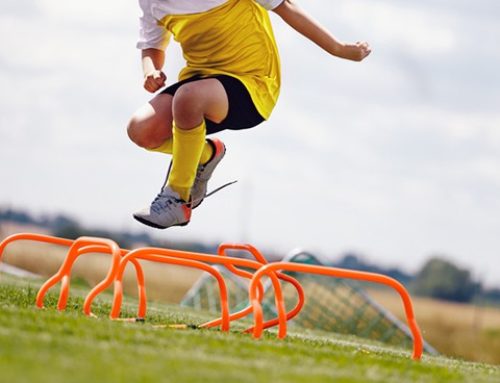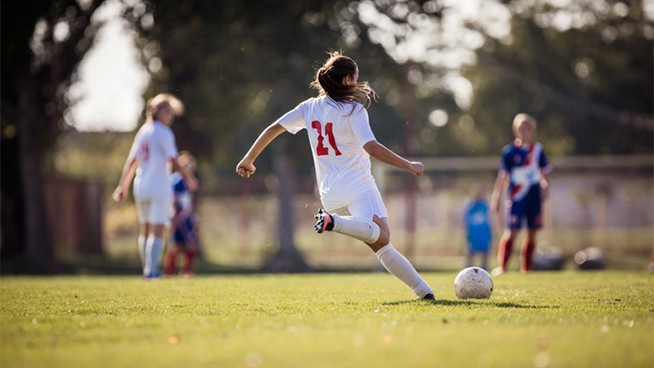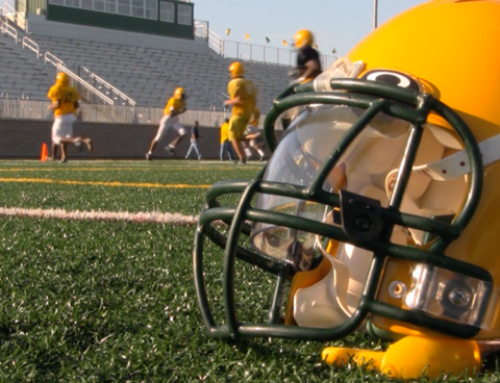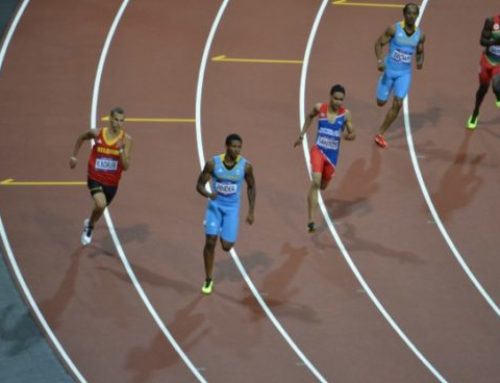Improve Your Arm Swing for Faster Sprints
![]()
The devil is in the details.
Your greatest improvements are going to come from the little things you do in preparation. When it comes to sprinting, the “little things” are the technical aspects of a race—most notably arm swing.
When we look at sprinting, it’s easy to focus on stride length and stride frequency because they play leading roles in being fast. Bottom line: it’s about the amount of force you can put into the ground and how often you do it. It’s a simple equation, so it’s no wonder that building explosive leg strength is a huge component of weight training programs for sprinters. But becoming stronger is only part of the overall picture.
RELATED: Speed Drill of the Day: Weighted Arm Swings
One of the most overlooked areas, especially for beginners, is the arm swing. It’s a huge factor in a sprint race. When you sprint, you need to get full range of motion from your arms. The amount of force you can generate from your arms, especially out of the blocks, largely determines how well you explode off the line and how fast you are ultimately able to run.
As I mentioned before, stride length and frequency are huge components of sprinting, but both are in part determined by the motion of the arms. The faster the arms go, the faster the legs go. Being lazy with your arms limits your ability to generate speed. So don’t ignore the minute details.
RELATED: Get Faster With This Sprint Form Checklist
Perfecting Your Arm Swing Technique

Arm angles are important, and any change can negatively alter your mechanics, which can set you up for a bad time. A good place to start is around 90 degrees at the elbow, which is where this mini-band cue comes into play.
A big cue for sprinters is that arm drive should come from the shoulders. The range of motion should be from your back pocket to your ear. This keeps the movement in a single plane of motion.
RELATED: Refine Your Sprinting Mechanics to Run a Faster Race
One last thing to be aware of—and the drills below can fix these technical issues—is to avoid driving your arms from side to side. Your arms should not go across your body. This causes all sorts of issues all the way through the body, mainly affecting the hips. And when the hips get affected, you can be sure your speed will decline.
Correct your technique issues in practice so they don’t pop up when it matters most, in competition.
Form and Technique Drills

Warm-ups are the perfect time to use Mini-Band Arm Swing drills. These are shown in the video above. Use them to hammer down your form, especially your arm mechanics. Placing a single mini-band on each arm will further ingrain proper arm mechanics.
This one tactile cue will give you instant feedback, because as soon as you slip and let your form go, the bands snap off. The mini-bands wrap around the hands and elbows, keeping your arms at 90-degree angles.
Think about your sprint mechanics as they are now. In all likelihood, you’d like to improve some things and clean up your movement patterns. It’s equally likely that correcting those things will instantly make you a little faster than before. Drills that focus on the arms and how the feet strike the ground do wonders for technique.
Takeaway
The best of the best take pride in attending to and perfecting the minute details of their races. That’s how they got to where they are. As an experienced competitive sprinter, I can tell you that details can make or break a race. Anything from how your blocks are set up to the distance they are from the line—every detail counts.
Nowhere is this truer than in the details of technique drills. Arm drills like the ones mentioned above can help you avoid wasted motion in your sprint. Wasted motion equals seconds off the clock. Don’t let details prevent you from success. Work on them until they are ingrained in your head and becomes second nature. This one cue/drill can help you get there.
Don’t practice until you get it right. Practice until you can’t get it wrong.
[cf]skyword_tracking_tag[/cf]RECOMMENDED FOR YOU
MOST POPULAR
Improve Your Arm Swing for Faster Sprints
![]()
The devil is in the details.
Your greatest improvements are going to come from the little things you do in preparation. When it comes to sprinting, the “little things” are the technical aspects of a race—most notably arm swing.
When we look at sprinting, it’s easy to focus on stride length and stride frequency because they play leading roles in being fast. Bottom line: it’s about the amount of force you can put into the ground and how often you do it. It’s a simple equation, so it’s no wonder that building explosive leg strength is a huge component of weight training programs for sprinters. But becoming stronger is only part of the overall picture.
RELATED: Speed Drill of the Day: Weighted Arm Swings
One of the most overlooked areas, especially for beginners, is the arm swing. It’s a huge factor in a sprint race. When you sprint, you need to get full range of motion from your arms. The amount of force you can generate from your arms, especially out of the blocks, largely determines how well you explode off the line and how fast you are ultimately able to run.
As I mentioned before, stride length and frequency are huge components of sprinting, but both are in part determined by the motion of the arms. The faster the arms go, the faster the legs go. Being lazy with your arms limits your ability to generate speed. So don’t ignore the minute details.
RELATED: Get Faster With This Sprint Form Checklist
Perfecting Your Arm Swing Technique

Arm angles are important, and any change can negatively alter your mechanics, which can set you up for a bad time. A good place to start is around 90 degrees at the elbow, which is where this mini-band cue comes into play.
A big cue for sprinters is that arm drive should come from the shoulders. The range of motion should be from your back pocket to your ear. This keeps the movement in a single plane of motion.
RELATED: Refine Your Sprinting Mechanics to Run a Faster Race
One last thing to be aware of—and the drills below can fix these technical issues—is to avoid driving your arms from side to side. Your arms should not go across your body. This causes all sorts of issues all the way through the body, mainly affecting the hips. And when the hips get affected, you can be sure your speed will decline.
Correct your technique issues in practice so they don’t pop up when it matters most, in competition.
Form and Technique Drills

Warm-ups are the perfect time to use Mini-Band Arm Swing drills. These are shown in the video above. Use them to hammer down your form, especially your arm mechanics. Placing a single mini-band on each arm will further ingrain proper arm mechanics.
This one tactile cue will give you instant feedback, because as soon as you slip and let your form go, the bands snap off. The mini-bands wrap around the hands and elbows, keeping your arms at 90-degree angles.
Think about your sprint mechanics as they are now. In all likelihood, you’d like to improve some things and clean up your movement patterns. It’s equally likely that correcting those things will instantly make you a little faster than before. Drills that focus on the arms and how the feet strike the ground do wonders for technique.
Takeaway
The best of the best take pride in attending to and perfecting the minute details of their races. That’s how they got to where they are. As an experienced competitive sprinter, I can tell you that details can make or break a race. Anything from how your blocks are set up to the distance they are from the line—every detail counts.
Nowhere is this truer than in the details of technique drills. Arm drills like the ones mentioned above can help you avoid wasted motion in your sprint. Wasted motion equals seconds off the clock. Don’t let details prevent you from success. Work on them until they are ingrained in your head and becomes second nature. This one cue/drill can help you get there.
Don’t practice until you get it right. Practice until you can’t get it wrong.
[cf]skyword_tracking_tag[/cf]











